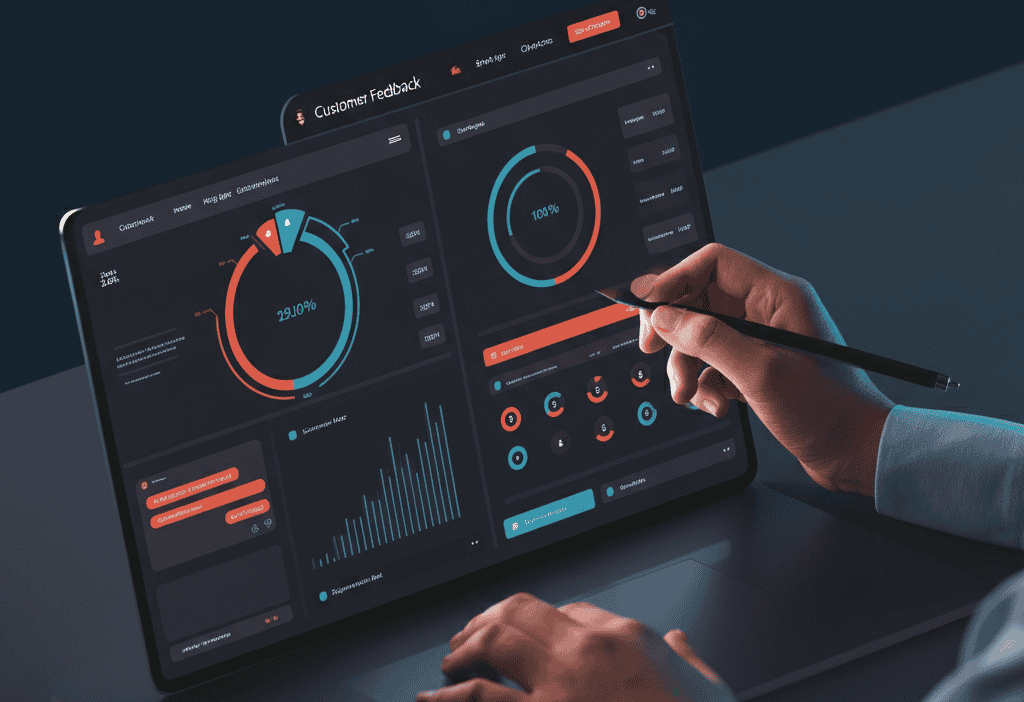Customer opinions can make or break your business. Every review, comment, and complaint contains valuable insights that could transform your operations, boost customer satisfaction, and drive revenue growth. Yet many companies treat feedback monitoring as an afterthought rather than a strategic priority.
Smart businesses understand that monitoring customer feedback isn’t just about damage control. It’s about creating a continuous loop of improvement that keeps you ahead of competitors and aligned with customer needs. When done effectively, feedback monitoring becomes a powerful tool for innovation, retention, and long-term success.
This guide will show you how to build a comprehensive feedback monitoring system that captures every voice, analyzes trends, and turns insights into action.
What Does Monitoring Customer Feedback Really Mean?
Monitoring customer feedback involves systematically collecting, tracking, and analyzing what customers say about your business across all touchpoints. This includes direct feedback through surveys and support channels, as well as indirect feedback from social media, review sites, and online forums.
Effective feedback monitoring goes beyond simply reading comments. It requires organizing feedback data, identifying patterns, measuring sentiment, and translating insights into concrete business improvements. The goal is to create a 360-degree view of customer satisfaction that informs decision-making at every level.
Modern feedback monitoring combines automated tools with human analysis to capture both quantitative trends and qualitative nuances. This approach ensures you catch emerging issues before they escalate while maintaining the context and empathy that only human interpretation can provide.
The Business Impact of Customer Feedback Monitoring
Companies that actively monitor customer feedback see measurable improvements across key performance indicators. Customer retention rates increase when businesses respond quickly to concerns and implement suggested improvements. Revenue grows as satisfied customers become brand advocates who drive word-of-mouth marketing.
Feedback monitoring also reduces costs by identifying operational inefficiencies and preventing small problems from becoming expensive crises. When you spot recurring complaints early, you can address root causes rather than constantly firefighting individual issues.
The competitive advantage is significant, too. Businesses that listen to customers consistently outperform those that rely solely on internal assumptions about market needs. Real customer insights drive product development, service improvements, and strategic decisions that resonate with your target audience.
Essential Channels for Customer Feedback Collection
Direct Feedback Channels
Survey tools remain one of the most reliable ways to gather structured feedback. Post-purchase surveys, Net Promoter Score (NPS) questionnaires, and customer satisfaction surveys provide quantifiable data that’s easy to track over time. The key is timing these surveys when customers are most likely to respond honestly.
Customer support interactions generate continuous feedback streams. Every support ticket, live chat conversation, and phone call contains valuable information about customer pain points and expectations. Training support teams to recognize and document feedback themes amplifies the value of these interactions.
Social Media and Online Reviews
Social media platforms serve as unfiltered feedback channels where customers share honest opinions about their experiences. Monitoring mentions, hashtags, and comments across Facebook, Twitter, Instagram, and LinkedIn reveals both positive endorsements and areas needing improvement.
Review sites like Google My Business, Yelp, Trustpilot, and industry-specific platforms capture detailed customer experiences. These reviews often include specific suggestions and highlight aspects of your business that customers value most or find frustrating.
Indirect Feedback Sources
Online forums, community groups, and discussion boards contain organic conversations about your industry and potentially your business. Customers often share candid opinions in these spaces, providing insights that formal surveys might miss.
Email responses, even those not explicitly requesting feedback, frequently contain valuable comments about customer experiences. Training teams to flag and categorize these informal feedback sources ensures no insights are overlooked.
Building Your Feedback Monitoring System
Technology and Tools
Customer relationship management (CRM) systems centralize feedback from multiple channels, making it easier to track individual customer journeys and identify patterns. Modern CRM platforms integrate with survey tools, social media monitoring, and review management systems for comprehensive visibility.
Social listening tools automatically track brand mentions across the internet, alerting you to conversations you might otherwise miss. These platforms often include sentiment analysis features that help prioritize responses and identify trending issues.
Review management platforms aggregate reviews from multiple sites and provide response management capabilities. Some tools offer competitive analysis features, showing how your feedback compares to industry benchmarks.
Creating Standard Operating Procedures
Establish clear protocols for who monitors which channels and how frequently. Daily monitoring might be necessary for social media and review sites, while monthly analysis could suffice for survey data trends. Consistency ensures nothing falls through the cracks.
Develop response templates for common feedback types while maintaining personalization. Quick, empathetic responses to negative feedback can often turn frustrated customers into loyal advocates. Positive feedback deserves acknowledgment too, reinforcing behaviors that drive satisfaction.
Create escalation procedures for serious complaints or viral negative feedback. Define triggers that require immediate management attention and establish communication protocols to ensure swift resolution.
Analyzing Feedback for Actionable Insights
Categorization and Tagging
Group feedback into categories like product quality, customer service, pricing, and user experience. This organization reveals which areas generate the most comments and helps prioritize improvement efforts. Subcategories provide even more granular insights for targeted action.
Tag feedback with sentiment indicators beyond simple positive or negative ratings. Neutral feedback often contains valuable suggestions, while highly emotional responses (both positive and negative) indicate strong customer feelings that deserve special attention.
Trend Analysis
Track feedback themes over time to identify improving or worsening areas. Month-over-month comparisons reveal whether recent changes have positively impacted customer satisfaction. Seasonal patterns might also emerge, helping you prepare for predictable feedback spikes.
Compare feedback across different customer segments, products, or service areas. B2B customers might prioritize different features than B2C users, and understanding these distinctions allows for more targeted improvements.
Sentiment Analysis
Automated sentiment analysis tools provide quick overviews of feedback tone, but human review adds crucial context. Sarcasm, cultural nuances, and complex emotions often require human interpretation to fully understand customer intent.
Track sentiment changes following specific business decisions or external events. This correlation helps measure the real impact of your actions on customer perception.
Turning Feedback Into Business Improvements

Prioritization Framework
Not all feedback demands immediate action. Create a framework that weighs factors like frequency of mentions, potential business impact, implementation difficulty, and alignment with strategic goals. This approach ensures resources focus on changes that deliver maximum value.
Consider the lifetime value of customers providing feedback. Input from high-value, long-term customers might carry more weight in decision-making than isolated complaints from one-time buyers.
Implementation and Communication
When you make changes based on customer feedback, tell your customers about it. This communication closes the feedback loop and demonstrates that you genuinely listen to their input. Customers who see their suggestions implemented become more engaged and likely to provide future feedback.
Track the results of feedback-driven improvements. Measure whether changes actually resolve the issues customers raised and improve overall satisfaction scores. This accountability ensures your monitoring efforts translate into real business value.
Cross-Department Collaboration
Share feedback insights across departments to maximize impact. Marketing teams can use positive feedback for testimonials and case studies. Product development can prioritize features based on customer requests. Sales teams can address common objections using insights from feedback analysis.
Create regular feedback review meetings where different departments discuss trends and coordinate responses. This collaboration prevents siloed thinking and ensures customer insights influence all aspects of your business.
Measuring the Success of Your Feedback Monitoring
Establish key performance indicators that demonstrate the value of your feedback monitoring efforts. Customer satisfaction scores, response times to negative feedback, and the percentage of customers who update their reviews after issue resolution provide concrete metrics for success.
Track business outcomes linked to feedback improvements. Revenue retention, customer lifetime value, and referral rates often improve when businesses effectively monitor and act on customer feedback. These metrics help justify the investment in comprehensive monitoring systems.
Transform Feedback Into Your Competitive Advantage
Monitoring customer feedback effectively requires commitment, the right tools, and a culture that values customer input. Companies that excel at this practice don’t just react to feedback—they proactively seek it out and use it to drive innovation and growth.
Start by auditing your current feedback sources and identifying gaps in your monitoring coverage. Implement tools and processes that match your business size and resources, then gradually expand your capabilities as you see results.
Remember that monitoring customer feedback is not a one-time project but an ongoing business practice. The companies that make feedback monitoring a core competency are the ones that build lasting customer relationships and sustainable competitive advantages.
Your customers are already talking about your business. The question is whether you’re listening closely enough to turn their insights into your next breakthrough.
Learn more: Turn Negative Reviews Into Growth Opportunities for Your E-commerce Store





